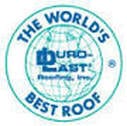Flat Roofing
Single-ply membranes are generally categorized as either thermoplastic or thermoset. Thermoplastic materials can be repeatedly softened when heated and hardened when cooled. Thermoset materials solidify, or “set,” irreversibly after heating. Single ply membranes commonly are referred to by their chemical acronyms.
Single-ply membranes may contain reinforcement layers. Common reinforcements for single ply membranes include polyester fabrics or scrims, glass fiber, or a felt or fleece backing. A finished sheet’s thickness typically is referred to as mil thickness. Common mil thicknesses for these sheet membranes range from 40 mils to 60 mils and are also produced thicker for specified projects.
Single-ply membranes can be installed fully adhered, mechanically attached or held down with ballast. In many instances, a combination of attachment methods are used to secure a roof system. For instance, to help your projected budget an insulation layer may be mechanically attached to the substrate with the roof membrane fully adhered to the insulation. This saves the cost of expensive insulation adhesive.






